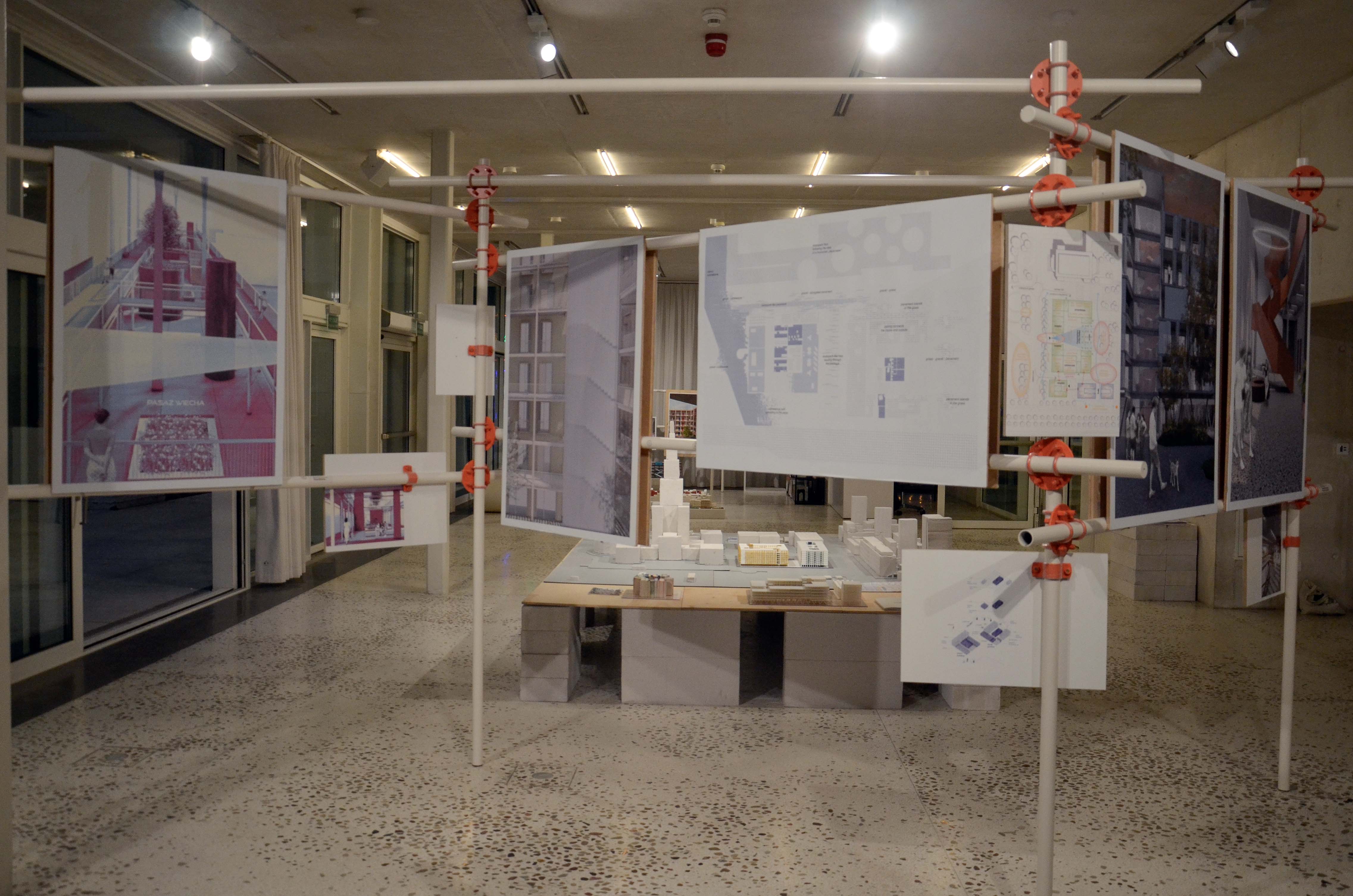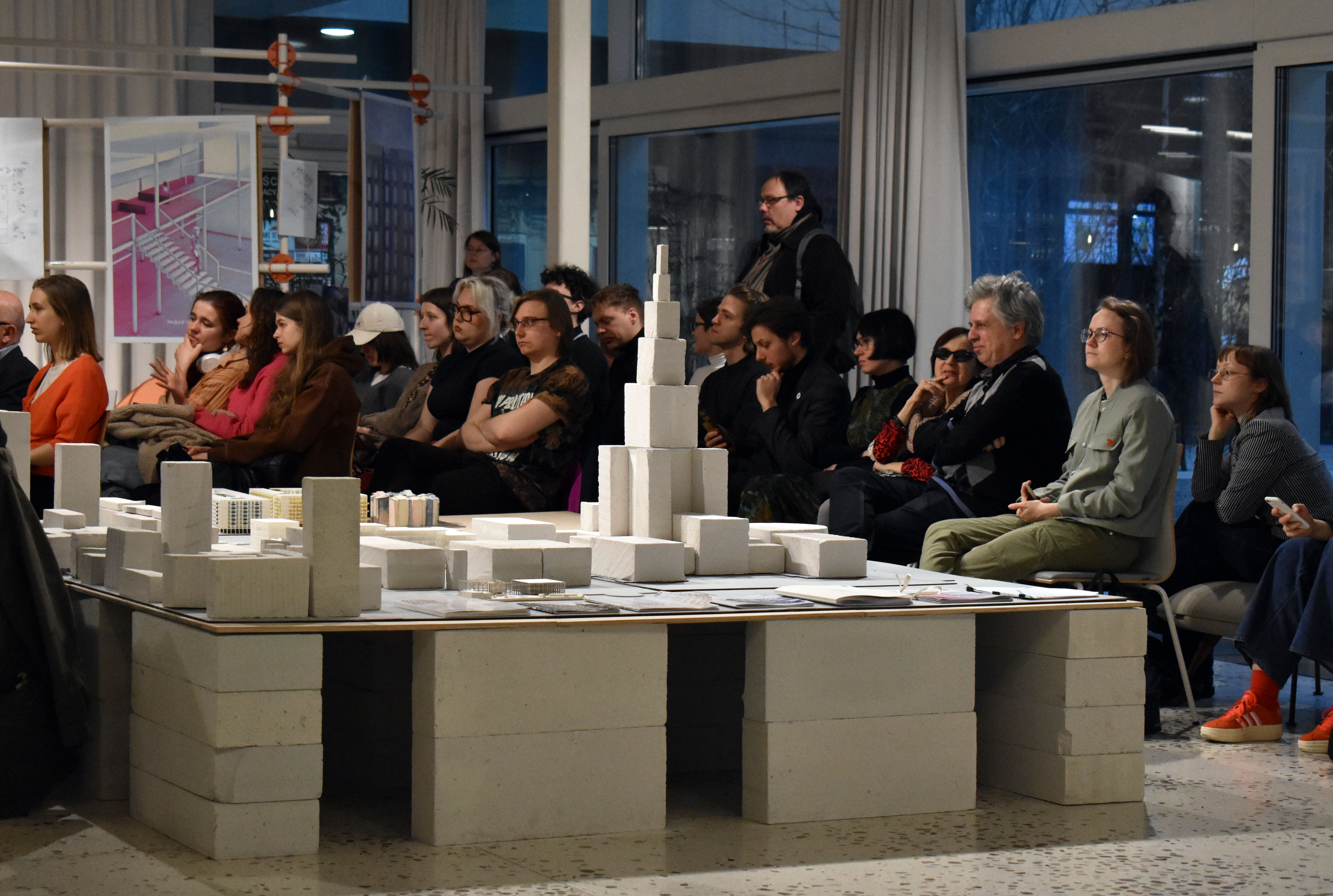.jpg)

.jpg)
.jpg)

Student exhibition at Warsaw architecture pavilion ZODIAK
The exhibition prepared by the Students of the Inclusive Housing Studio at the Faculty of Architecture in Brno has attracted a large audience and generated significant discussion on the importance of building new dormitories and infrastructure for students.
The topic has been highly relevant and crucial for the city because of the proposed location: the site next to the Plac Defilad in Warsaw, just next to the Palace of Culture and Science, the Museum of Modern Art and the new Central Square. For the realisation of affordable housing for young people, we have chosen the most central and one of the most expensive plots of land in Poland. The manifesto behind the project: we must stop pushing young people to suburban campuses and bring student life back to the city centre. Above all, we must start building more public and affordable student housing and infrastructure, even on the most expensive and prestigious plots of the city. The true value lies not in money, but in the social and cultural impact that young people bring to the city.
.jpg)
Exhibition opening | Photo: Natalia Cichoń
The exhibition wouldn’t be possible without the great effort and engagement of the students who came to Warsaw to prepare it: Vilma Belanská, Adam Hajdák, Petra Hanušová, Tereza Kusnierzová, Barbora Olivová, David Dubáň, Tomáš Wolf and Matteo Marchese (graduate).
We are very happy that our students contributed to the very important architectural and political discussion in Warsaw!

Exhibition Student Quarter Plac Defilad | Photo: Matteo Marchese
Response to the Exhibition and Political Initiative
Polish Deputy Minister of Science, Dr Karolina Zioło-Pużuk, inspired by the varied and multi-voice discussion accompanying the exhibition has proposed the organization of a bigger scale seminar on the dormitories in the parliament and has invited Inclusive Housing Studio teacher, Zuzanna Mielczarek to contribute and coorganize the discussion.
The debate
The debate was a unique opportunity for a cross-sectional exchange of experiences and ideas related to the availability of housing and infrastructure for students, between the Deputy Minister of Science, Dr. Karolina Zioło-Pużuk, architect of dormitories and lecture buildings, Karolina Tunajek from Projekt Praga, architecture graduate and trade union activist, Dominika Zymni and academic teacher and architect, Zuzanna Mielczarek.
.jpg)
Photo: Matteo Marchese
In 2024, the University of Warsaw opened a new Student House on the Służewiec campus. This extremely successful project by the Projekt Praga architectural studio is the first new dormitory at the University of Warsaw to be built since the 1970s, i.e. more than 50 years. In turn, the last dormitory commissioned at the Warsaw University of Technology is from 1985. Since then, universities have not undertaken the construction of new student accommodation.
.jpg)
Photo: Natalia Cichoń
Meanwhile, there are currently 1.2 million students studying in Poland, of which around 250,000 are in Warsaw. The eight largest academic centres offer a total of only 82,000 places in student dormitories, with only around 10,000 available in Warsaw alone. Therefore, getting a place in a dormitory is not easy. If you do manage to get a place, the conditions are often extreme and the location is usually peripheral.
Is there an alternative?
Students and young adults are among the most vulnerable groups in the housing market because they face both a shortage of accommodation offered by universities and a lack of affordable housing. In addition, they are often victims of exploitation by private landlords. Meanwhile, the centres of large cities, which were once teeming with student energy, are undergoing increasing gentrification, making them financially inaccessible.

Photo: Natalia Cichoń
An example of this is the attempt to privatize and demolish the Jowita Student Hall of the Adam Mickiewicz University in Poznań, which was successfully defended thanks to the involvement of young activists. A similar problem is the shortage of public and cheap canteens, which makes everyday life even more difficult for students.
Questions we asked:
How can we bring student life back to city centres?
How can we design dormitories to make students' lives better?
What is the current financing model for the construction of new student dormitories?
Copies of the book “Jowita Stays. The Story of 10 Days of the Student Movement” by the Youth Circle of the Employee Initiative “Jowita stays. The Story of 10 Days of the Student Movement” were available for download at the event.
Dr. Karolina Zioło-Pużuk
Secretary of State at the Ministry of Science and Higher Education.
Karolina Tunajek
Architect, Projekt Praga studio – the studio has completed, among others, the Sulima student hall of residence on the University of Warsaw's Służewiec campus and the new building for the University of Warsaw's Faculty of Psychology on the Ochota campus.
Dominika Zymni
Trade union activist of the Youth Circle of the Employee Initiative, architecture graduate. She will talk about the activities of the Youth Circle in defence of public dormitories and to improve the accessibility of infrastructure for students, e.g. canteens.
Zuzanna Mielczarek
Academic teacher, runs the Inclusive Housing Studio at the Faculty of Architecture in Brno (together with Kacper Kępiński), PhD student at the Faculty of Architecture at the Warsaw University of Technology, exhibition curator at the National Institute of Architecture and Urban Planning.
| Inserted by: | Tran Lucie |
|---|---|
| Inserted | |
| Last updated |